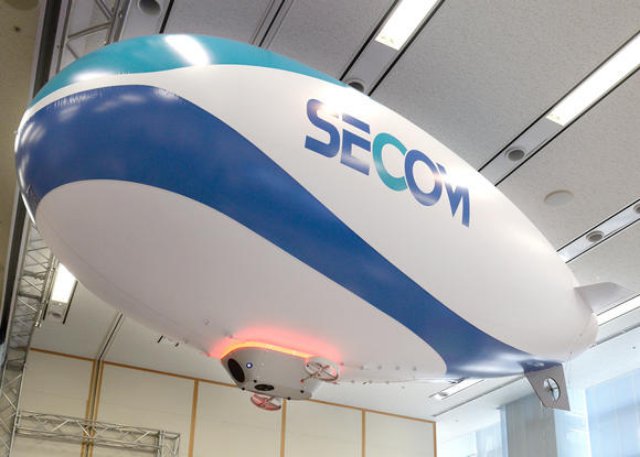Secom Co., Ltd. will use unmanned airships for its security service starting in 2016, leveraging information technology to address an expected personnel shortage heading into the Tokyo Olympics.
The technology is expected to help track suspicious persons at events and direct evacuations when disasters strike.
“This dramatically enhances our ability to secure a large area,” President Hiroshi Ito said last Wednesday at a news conference, lauding a product that the company spent three years developing.
The gas-filled airships will be 15 meters long and have a top speed of 50kph. Able to stay airborne for up to two hours, they will monitor the ground from an altitude of 100 meters, meaning they will not be subject to aviation regulations.
If an airship detects suspicious people, vehicles or other threats, it will convey the information to guards so they can arrive at the scene quickly. The ships will also be linked to surveillance cameras on the ground as well as with security drones that Secom plans to launch next spring.
The airships can fly as long as there are no wind gusts or other extreme weather conditions. In Tokyo, for example, they are expected to be cleared for takeoff about 90% of the time. Secom intends to deploy the ships in eight locations across Japan by 2018. The daily cost of the service will be about 1 million yen ($8,200).
Currently, international sports competitions and other major events require extra security staff, pushing the related costs beyond 10 million yen a day. Aerial reconnaissance is expected to reduce the need for additional guards, resulting in lower costs.
Companies worldwide are turning their sights skyward to bolster their services. Google plans to use balloons floating in the stratosphere as relay stations for wireless Internet connections, while Amazon.com aims to deliver merchandise using drones. And Japan’s Sohgo Security Services, or Alsok, is using drones to inspect panels at megasolar plants.
The domestic security market is projected to grow by 100 billion yen over five years to 700 billion yen in 2017, according to research company Fuji Keizai. Although the market is promising, security companies could run into problems if they rely on manpower, especially in light of the recent labor shortage and the nation’s dwindling working population.
Secom expects its new airships to play an important role in the 2020 Tokyo Olympics. According to some estimates, security companies will need 14,000 personnel for the games. While some 540,000 currently work in the security industry, they cannot simply abandon their duties to help guard Olympic venues.
Cashing in on technology
Secom’s trump card is its information technology prowess. It seeks to create new businesses by analyzing big data regarding the movement of people and goods. Using airships to collect information and applying it for security purposes symbolizes its embrace of IT.
The company has also delivered to a data center in Okinawa Prefecture a security system whose facial-recognition technology allows personnel to enter and leave the facility without stopping. Another service in the pipeline involves a wearable device that would monitor a customer’s pulse and establish contact with Secom’s nurses if an abnormality is detected.
Demand for various services in Japan is forecast to grow, partly due to the influx of foreign tourists. The domestic service industry has long been said to have low productivity. Secom’s latest efforts will likely be a test case to see if Japan’s service sector has the strength to overhaul its business model.
Source: Nikkei Asian Review

